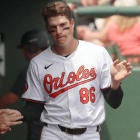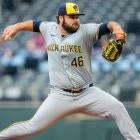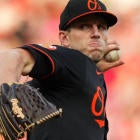The offseason is full of storylines that are long forgotten seemingly moments after the first pitch is delivered on opening day, but we're going to revisit a common offseason theme right here, right now, in the middle of June.
As in most offseasons, the months leading up to the start of the 2014 campaign were rife with reports of pitchers changing their arsenals. Several were reportedly adding pitches, while others tinkered with existing ones, and more still decided to ditch a pitch. As with many offseason storylines, some of those in this genre wound up making little lasting impact. Stephen Strasburg adding a new slider? Ever since abandoning it in April, the only ones he has seen have been from White Castle. Jake Peavy has used his new splitter in only one start this year. Sadly, Brian Wilson has thrown exactly one knuckleball, according to BrooksBaseball.net.
Some pitchers have followed through on their offseason plans and have unveiled new or improved pitches. Change isn't always good, though, and for the six pitchers reviewed here, the results have been mixed. Few Fantasy owners likely pinned their hopes on a pitcher on draft day just because he was tweaking his arsenal, but for at least a handful of hurlers, the changes have made an impact. The fallout from the enhanced arsenals -- including the good and the bad -- is detailed below, and there are some useful lessons for Fantasy owners to note.
Note: All pitch data is from BrooksBaseball.net, except where otherwise noted. Current season stats are for games played through Tuesday, June 17.
Phil Hughes, Twins: Wisely, Hughes has done away with his slider, which according to the pitch value data on FanGraphs.com, was one of the least effective in the majors last season. He dusted off his cutter, which went all but unused since 2011, and to good effect. He has used it 24 percent of the time, and it has been a reliable ground ball pitch. Hughes' overall ground ball rate has barely risen, increasing from just 33 percent last season to 35 percent, but opponents have put together a meager .078 Isolated Power on his cutter. Also key to Hughes' success has been an improved curveball, which he is throwing harder and with greater movement and has generated an .088 Isolated Power (as compared to last season's .231 mark). That goes a long way toward explaining how Hughes has improved so drastically, and showing consistency even in recent starts at Rogers Centre and Fenway Park. With extra-base hits no longer as much of a threat, owners can be confident in starting Hughes every week.
Michael Wacha, Cardinals: Wacha didn't use his curve much until last postseason, and after working on it during the offseason he has relied on it more frequently in 2014. Though he has used it for only 11 percent of his pitches, FanGraphs.com has Wacha ranked 13th among all qualifying pitchers for curveball pitch value. He uses it mostly as a first pitch and has been getting called strikes on it frequently. That may have something to do with Wacha plowing through his plate appearances more efficiently (3.73 pitches per plate appearance, down from 3.98 last year) and lasting six innings or more in all but three of his 15 starts. It's just one more element that makes Wacha one of the top 25 starting pitchers in Fantasy.
Shelby Miller, Cardinals: While Wacha looks like a staple for years to come in the Cardinals' rotation, Miller has done little but raise doubts about his chances to be a future star. He started using a cutter late last season, and after refining it during the off months he has used it and his curveball as his main secondary pitches. The cutter has been his best pitch for inducing whiffs on a per-pitch basis, but it has also contributed to his control problems, as he has thrown 45 percent of them for balls. Miller has had just as many problems commanding his curve, and worse yet, he has coaxed swings on only 33 percent of those offerings. His cutter and fastball command have actually improved over the past month, so Miller is experiencing something of a rebound, but with few swings and misses overall, he is not yet a reliable weekly option.
Sonny Gray, Athletics: Gray didn't use his changeup much in his rookie season, and when he did it often got whacked for extra bases. After some offseason tinkering, Gray has come back relying on his changeup more often, using it on 18 percent of his pitches. After allowing hitters to post a .177 Isolated Power on changeups last season, Gray has dropped that mark to .120 so far in 2014. It's probably no coincidence that Gray's grounder rate on his changeup has increased from 44 percent to 68 percent. That has helped Gray to succeed, even though his swinging strike rate on his four-seam fastball has fallen from 8 percent to 6 percent. He may not return to being the strikeout-per-inning pitcher he was last year, but with an improved changeup, he can prevent runs by way of the ground ball. With a strong infield defense behind him, he just may be able to maintain a sub-1.20 WHIP as well.
Tyson Ross, Padres: Though he has never used it much, Ross spent some time in the offseason working on his changeup. As in the past, this season he has used it primarily against lefties, and most often as a first pitch. As his Fantasy owners are well aware, Ross has had some major control issues at times and they have come mostly when facing left-handed batters. According to FanGraphs.com, Ross has a respectable 2.6 BB/9 ratio against righties but an atrocious 5.0 mark versus lefties. It certainly hasn't helped that he has thrown 53 percent of his changeups against lefties for balls. Though Ross doesn't throw the pitch often, it isn't helping him to get ahead in counts and could be impacting his ability to throw his sinker for strikes. To make matters worse, Ross' changeup has gotten hammered when batters have connected with it. The good news for Fantasy owners is that Ross has been more effective overall against lefties this season, but that seems to have much more to do with him using his sinker more often than on any alterations he has made to his changeup. Keep an eye on Ross' changeup usage, as the less he employs it, the better.
Tony Cingrani, Reds: Last season, Cingrani was almost totally reliant on his fastball, so he approached this season intending to use his slider more often. Cingrani followed through on his intent, using his slider 13 percent of the time, but the results have been far from impressive. Though batters have hit grounders at a 59 percent rate on Cingrani's slider, they have generally laid off the pitch (33 percent swing rate), as he has thrown it for a ball more often than for a strike. Cingrani's control issues have resulted in a 4.7 BB/9 ratio, 1.49 WHIP and a demotion to the Reds' bullpen. The lefty has actually shown good command of his fastball, so he might be better off going without a secondary pitch. He was successful last season with a more limited arsenal, so there is hope that Cingrani can be a factor in Fantasy again this season. He is worth stashing despite his horrid performance to date this year.
Stay in touch with the most passionate Fantasy staff in the business by following us on Twitter @CBSFantasyBB or Al at @almelccbs .





















